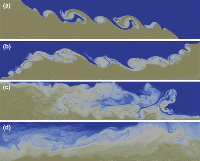Disperse Two-Phase Flows, with Applications to Geophysical Problems
Berselli L. C. , M. Cerminara, T. Iliescu (2015).
Pure and Applied Geophysics, 172, 1, 181-196, doi:10.1007/s00024-014-0889-5.
Abstract
In this paper, we study the motion of a fluid with several dispersed particles whose concentration is very small (smaller than 10 −3 10−3), with possible applications to problems coming from geophysics, meteorology, and oceanography. We consider a very dilute suspension of heavy particles in a quasi-incompressible fluid (low Mach number). In our case, the Stokes number is small and—as pointed out in the theory of multiphase turbulence—we can use an Eulerian model instead of a Lagrangian one. The assumption of low concentration allows us to disregard particle–particle interactions, but we take into account the effect of particles on the fluid (two-way coupling). In this way, we can study the physical effect of particles’ inertia (and not only passive tracers), with a model similar to the Boussinesq equations. The resulting model is used in both direct numerical simulations and large eddy simulations of a dam-break (lock-exchange) problem, which is a well-known academic test case.
http://link.springer.com/article/10.1007%2Fs00024-014-0889-5


